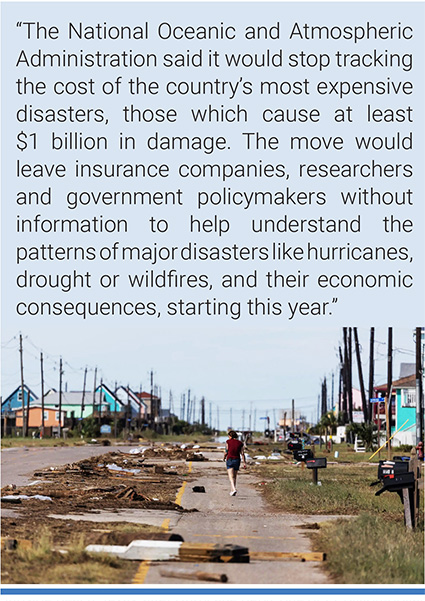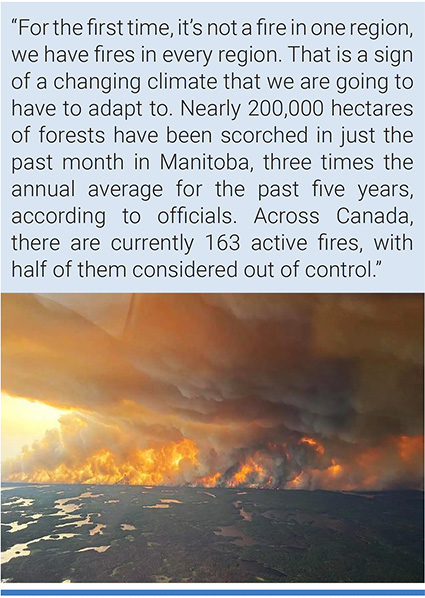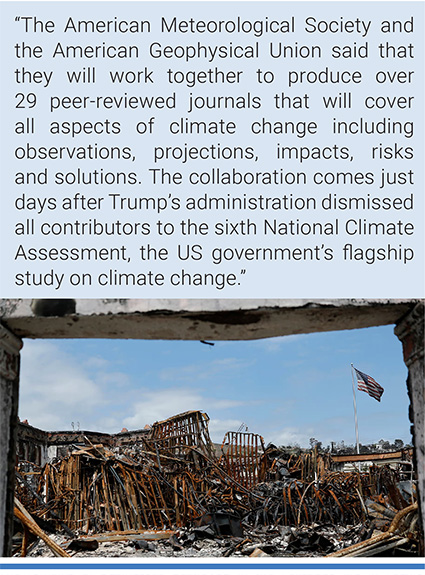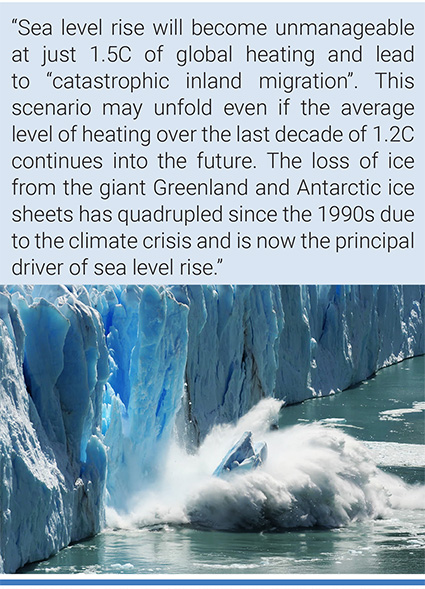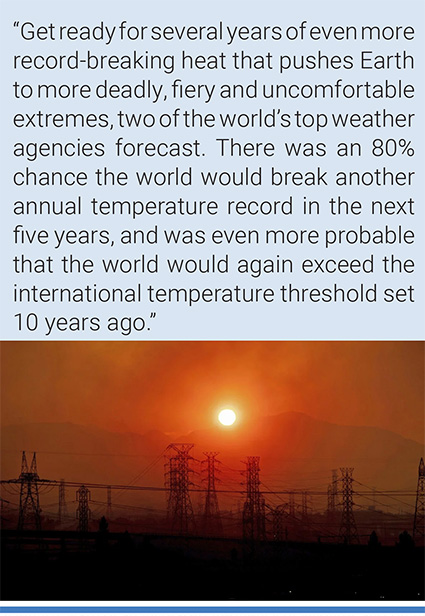Monthly Summaries
Issue 101, May 2025 | "A dire picture"
[DOI]
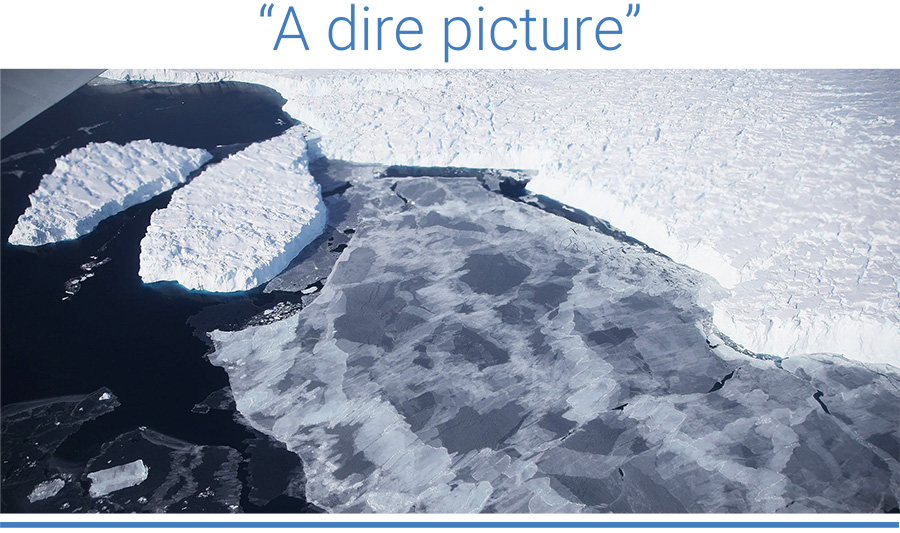
Ice floats near the coast of West Antarctica. Scientists are concerned the West Antarctic Ice Sheet may be in a state of irreversible decline directly contributing to rising sea levels. Photo: Mario Tama/Getty Images.
May media coverage of climate change or global warming in newspapers around the globe crept up 0.2% from April 2025. Yet, coverage in May 2025 dipped 17% from May 2024. Figure 1 shows trends in newspaper media coverage at the global scale – organized into seven geographical regions around the world – across 21 years, from January 2004 through May 2025. Across wire services we monitor – The Associated Press, Agence France Presse, The Canadian Press, and United Press International (UPI) – coverage increased 5% from April 2025 but was 38% lower than coverage in May 2024.

Figure 1. Newspaper media coverage of climate change or global warming in print sources in seven different regions around the world, from January 2004 through May 2025.
At the regional level, May 2025 coverage – compared to the previous month – went up in Latin America. (+6%) (see Figure 2), the European Union (EU) (+6 %), and Oceania (+30%). Meanwhile, coverage dropped 1% in Asia while it dipped 18% in Africa, went down 21% in the Middle East, and decreased 24% in North America. Comparing these May 2025 levels of coverage to a year previous (May 2024), counts increased 6% in the Middle East and 38% in Oceania but decreased in Africa (-18%), Asia (-1%), the EU (-13%), Latin America (-22%) (see Figure 2) and North America (-24%).

Figure 2. Coverage of ‘cambio climático’ or ‘calentamiento global’ in Spanish and ‘mudanças climáticas’ or ‘aquecimento global’ in Portuguese in Latin America from January 2005 through May 2025 in El Universal (México), Reforma (México), La Nación (Costa Rica), El Comercio (Perú), El Comercio (Ecuador), El País (Uruguay), La República (Uruguay), El Tiempo (Colombia), El Espectador (Colombia), La Razón (Bolivia), O'Globo (Brasil), Folha de Sao Paulo (Brazil), La Nación (Argentina), Clarín (Argentina) and El Mercurio (Chile).
Refrigerators on display at a Home Depot in Orlando, Florida. Photo: John Raoux/AP. |
Moving to the content of coverage, many media portrayals in May 2025 covered various political and economic themes in stories. To begin the month, the May 3 election in Australia – with climate change policy stances embedded in the voter priorities and candidate comments – generated media attention. For example, CNN journalists Harry Whiteman and Angus Watson reported, “Australia’s Prime Minister Anthony Albanese has secured a second term in office in a disastrous night for his conservative rivals, as voters chose stability over change against a backdrop of global turmoil inflicted by US President Donald Trump. Australia’s return of a left-leaning government follows Canada’s similar sharp swing towards Mark Carney’s Liberal Party, another governing party whose fortunes were transformed by Trump. The loss of Liberal Party leader Peter Dutton’s seat mirrors that of Conservative Party leader Pierre Poilievre. While Australia wasn’t facing the same threats to its sovereignty as Canada, Trump’s global tariffs and policy swings have undermined Australians’ trust in the US, according to recent surveys… Albanese first took office in the so-called “climate election” of 2022, with promises to cut Australia’s carbon emissions and reach net zero by 2050. Despite a rapid rollout of renewable projects – enough to power 10 million homes – his government has been criticized for also approving new coal and gas projects. On Saturday, Albanese reiterated his commitment to climate action in contrast to the rolling assault inflicted by the new US administration on environment agencies and research”.
Back in the US, further Trump Administration cuts to climate change and environmental research continued to flow into the news. For example, Washington Post journalist Maxine Joselow reported, “The Environmental Protection Agency plans to end Energy Star, a popular program whose iconic blue labels have certified the energy efficiency of home appliances for more than three decades, according to three people briefed on the matter and documents reviewed by The Washington Post. During an all-hands meeting Monday of the EPA’s Office of Atmospheric Protection, Trump administration officials announced that the office would be dissolved and that Energy Star would be eliminated, the three people said, speaking on the condition of anonymity because they were not authorized to comment publicly. Officials also outlined the changes in slide presentations obtained by Democrats on the Senate Environment and Public Works Committee. The presentations, which were shared with The Post, state that “staff in restructured/eliminated organizations may be reassigned to other positions” …The end of Energy Star, first reported by CNN, builds on the Trump administration’s broader attacks on energy efficiency standards for appliances found in millions of American homes. Such standards have become a flash point in the nation’s culture wars and a source of conservative resistance to President Joe Biden’s environmental agenda. President Donald Trump floated canceling or privatizing Energy Star during his first term, but that plan didn’t materialize before he left office. Now, his partial budget proposal calls for eliminating the EPA’s Office of Atmospheric Protection but is silent on Energy Star. The office, according to the proposal, “is an overreach of Government authority that imposes unnecessary and radical climate change regulations on businesses and stifles economic growth.” The Energy Department also plays a small role in running Energy Star, and Trump’s budget calls for slashing around $2.6 billion from the agency’s Office of Energy Efficiency and Renewable Energy. A spokeswoman for the Association of Home Appliance Manufacturers, which represents companies that make a variety of appliances, suggested that the EPA could transfer Energy Star to the Energy Department”. As a second example, New York Times correspondents Rebecca Dzombak and Hiroko Tabuchi wrote, “The National Oceanic and Atmospheric Administration said on Thursday it would stop tracking the cost of the country’s most expensive disasters, those which cause at least $1 billion in damage. The move would leave insurance companies, researchers and government policymakers without information to help understand the patterns of major disasters like hurricanes, drought or wildfires, and their economic consequences, starting this year. Those events are becoming more frequent or severe as the planet grows hotter, although not all disasters are linked to climate change. It’s the latest effort from the Trump administration to restrict or eliminate climate research. In recent weeks the administration has dismissed the authors working on the nation’s biggest climate assessment, planned to eliminate National Parks grants focused on climate change, and released a budget plan that would cut significantly climate science from the U.S. Geological Survey and the Energy and Defense departments”.
Surfside Beach, Texas, after Hurricane Beryl, one of 27 billion-dollar weather or climate disasters. Photo: Adrees Latif/Reuters. |
Several ecological and meteorological-themed media stories continued to be carried in news outlets in May. To begin, in Europe, drought – connected to a changing climate – was prominent in news account. For example, El País journalists Matías Helbig, Raquel Villaécija and Eva Millán noted, “while on the Iberian Peninsula, the first four months of the year were, according to the Ministry for Ecological Transition, the eighth wettest in the historical record—which begins in 1961—in countries such as Ireland, the United Kingdom, Germany, Sweden, and Poland, barely a drop of rain has fallen since February. This is demonstrated by the precipitation maps of the European climate change observation organization Copernicus. If the trend continues, in a territory that stretches from northern France to the Scandinavian Peninsula, the arrival of a hot and dry summer could make things difficult. The climate reversal occurring in Europe is due to the anomalous behavior of what is known as the jet stream”.
Meanwhile, in South Asia analysis of the heat waves in the previous month revealed connections with a changing climate. This generated news. For example, Times of India journalist Gaurav Talwar wrote, “The early arrival of the heatwave in April, scorching large parts of India and Pakistan with temperatures exceeding 40oC across North India and reaching 49oC in parts of Pakistan was largely driven by human-induced climate change, finds a study by climate experts from several countries”.
A fire in on the city boundaries of Flin Flon, a community of some 5,000 people. Photo: Government of Manitoba, Canada. |
In late May in North America, Canadian wildfires earned media coverage with some stories making links with climate change. For example, Le Monde reported, “The western Canadian province of Saskatchewan declared a wildfire emergency on Thursday, May 29, becoming the second to do so after neighboring Manitoba had ordered 17,000 people to quickly flee their homes in remote communities a day earlier. "It's a very serious situation that we're faced with in Saskatchewan," the province's Premier Scott Moe told a news conference…Manitoba Premier Wab Kinew has said the province was experiencing its worst start to a wildfire season in years. "This is the largest evacuation Manitoba will have seen in most people's living memory," he told a news conference late Wednesday. The widespread nature of the fires was also cause for alarm, he warned. "For the first time, it's not a fire in one region, we have fires in every region. That is a sign of a changing climate that we are going to have to adapt to." Nearly 200,000 hectares of forests have been scorched in just the past month in Manitoba, three times the annual average for the past five years, according to officials. Across Canada, there are currently 163 active fires, with half of them considered out of control. Flin Flon, a mining town about 800 kilometers north of Winnipeg with about 5,000 residents, is the largest single community to be evacuated so far this year”. As a second example, BBC correspondent Nadine Yousef reported, “Canadian officials are warning of tough days ahead for fighting growing wildfires in Saskatchewan and Manitoba with hot and dry weather in the weekend forecast. The wildfires have forced thousands to evacuate in the two central prairie provinces, with both this week declaring states of emergency. In Manitoba, the entire city of Flin Flon has been emptied, except for firefighters and support workers, as a large blaze threatens the community. Smoke from the fires has triggered air quality alerts in Canada and as far as Chicago…There is also concern smoke from Canada's fires could affect the G7, being held in mid-June in Alberta. Fires are currently burning in the northern part of the province. There are currently seven fires considered "of note", meaning they may pose a threat to people or infrastructure, out of 50 burning in the province. Canada experienced its worst wildfire season on record in 2023, when over 42 million acres (17.3m hectares) burned - an area larger than all of England - and more than double the previous record. Smoke from those wildfires blanketed cities south of Canada's border into the US, including New York City. But the 2023 fires were more acutely felt in Alberta, British Columbia, the Northwest Territories, Nova Scotia, Ontario and Quebec. This year, it is Saskatchewan and Manitoba that are seeing the largest fires to date. Fires happen naturally in many parts of the world. It is difficult to know if climate change has caused or worsened a specific wildfire because other factors are also relevant, such as changes to the way land is used. But climate change is making the weather conditions needed for wildfires to spread more likely, the IPCC, the UN's climate body, says”.
Data is from the third quarter of 2022 through the first quarter of 2025. Excludes roughly $14 billion where the congressional district is unclear or the seat is vacant. Source: Clean Investment Monitor. |
Next, there were cultural-themed stories relating to climate change or global warming in May. For example, Washington Post journalist Scott Dance noted, “some National Weather Service forecasting teams are so critically understaffed that the agency is offering to pay moving expenses for any staff willing to transfer to those offices, according to notices recently sent to employees and obtained by The Washington Post. The worker shortages have forced several offices to stop operating 24 hours a day — a drastic step for an agency whose ethos is to prepare and warn a “weather-ready” nation. The 155 vacancies the agency is seeking to fill by May 27 include key weather forecasting positions at offices in coastal Texas and Louisiana, states that could face threats when the Atlantic hurricane season begins in a few weeks. The National Oceanic and Atmospheric Administration, the weather service’s parent agency, is also asking large numbers of meteorologists to move to offices in Alaska and across the northern Plains in Nebraska, Wyoming and South Dakota. In four forecasting offices — two in California’s Central Valley, one in western Kansas and another in eastern Kentucky — the staffing is so thin that there aren’t enough meteorologists to cover an overnight shift, according to the National Weather Service Employees Organization, a union representing NOAA rank and file. Offices in Wyoming, Michigan, Oregon and Alaska are expected to soon follow suit, the union said. That development is elevating fears that without the transfers or new hires, more offices will struggle to monitor coming weather threats, issue aviation forecasts and launch weather balloons around-the-clock, according to current and former weather service officials who spoke on the condition of anonymity because they were not authorized to speak for the agency. The circumstances lay bare how significantly the Trump administration has whittled away the corps of public servants responsible for the forecasting, warnings and information that can protect lives and property when extreme weather strikes. An estimated 500 National Weather Service employees have been fired or taken early retirements this year, out of a staff that numbered more than 4,200 before President Donald Trump began his second term, the officials said”.
Also, New York Times correspondents Brad Plumer and Harry Stevens reported, “Sprawling wind farms in Wyoming. A huge solar factory expansion in Georgia. Lithium mines in Nevada. Vacuums that suck carbon from the air in Louisiana. Over the past three years, companies have made plans to invest more than $843 billion across the United States in projects aimed at reducing planet-warming emissions, driven by lucrative tax credits for clean energy provided by the 2022 Inflation Reduction Act. But only about $321 billion of that money has actually been spent, with many projects still on the drawing board, according to data made public this month by the Clean Investment Monitor, a joint project of the Rhodium Group and the Massachusetts Institute of Technology. Now, much of the rest, about $522 billion, will depend on action playing out on Capitol Hill. Republicans in Congress are hotly debating proposals to roll back tax credits for low-carbon energy as they search for ways to pay for a roughly $4 trillion tax cut package favored by President Trump… The prospect of repeal has set off a furious lobbying battle in Washington, with energy companies pleading with lawmakers to preserve the tax breaks. At least three dozen Republicans have asked their colleagues to keep at least some tax credits to protect jobs in their districts and reduce electricity prices. But a nearly equal number of conservative House members are pushing publicly to kill the climate law altogether”.
The remains of businesses destroyed in the Palisades fire in Pacific Palisades, California. Photo: Mario Tama/Getty Images. |
Last, many scientific themes within news stories about climate change or global warming persisted in the month of May. For instance, media stories captured how politics shaped ongoing pursuits of scientific research in the US. For example, Guardian reporter Maya Yang wrote, “two major US scientific societies have announced they will join forces to produce peer-reviewed research on the climate crisis’s impact days after Donald Trump’s administration dismissed contributors to a key Congress-mandated report on climate crisis preparedness. On Friday, the American Meteorological Society (AMS) and the American Geophysical Union (AGU) said that they will work together to produce over 29 peer-reviewed journals that will cover all aspects of climate change including observations, projections, impacts, risks and solutions. The collaboration comes just days after Trump’s administration dismissed all contributors to the sixth National Climate Assessment, the US government’s flagship study on climate change. The dismissal of nearly 400 contributors had left the future of the study in question; it had been scheduled for publication in 2028. The NCA had been overseen by the Nasa-supported Global Change Research Program – a key US climate body which the Trump administration also dismissed last month. The reports, which have been published since 2000, coordinated input from 14 federal agencies and hundreds of external scientists. In its announcement on Friday, the two societies said: “This effort aims to sustain the momentum of the sixth National Climate Assessment (NCA), the authors and staff of which were dismissed earlier this week by the Trump administration, almost a year into the process.” According to the AMS and AGU, the collection will not replace the NCA but instead create a mechanism for important work on climate change’s impact to continue”.
The loss of ice from the Greenland and Antarctic ice sheets has quadrupled since the 1990s. Photo: Bernhard Staehli/Shutterstock. |
Also in May 2025, new research in Nature Communications about global warming and polar ice sheets earned media coverage in May. For example, CNN correspondent Laura Paddison reported, “The world’s ice sheets are on course for runaway melting, leading to multiple feet of sea level rise and “catastrophic” migration away from coastlines, even if the world pulls off the miraculous and keeps global warming to within 1.5 degrees Celsius, according to new research. A group of international scientists set out to establish what a “safe limit” of warming would be for the survival of the Greenland and Antarctic ice sheets. They pored over studies that took data from satellites, climate models and evidence from the past, from things like ice cores, deep-sea sediments and even octopus DNA. What they found painted a dire picture. The world has pledged to restrict global warming to 1.5 degrees Celsius above pre-industrial levels to stave off the most catastrophic impacts of climate change. However, not only is this limit speeding out of reach — the world is currently on track for up to 2.9 degrees of warming by 2100. But the most alarming finding of the study, published Tuesday in the journal Communications Earth and Environment, is that 1.5 might not even be good enough to save the ice sheets. Even if the world sustains today’s level of warming, at 1.2 degrees, it could still trigger rapid ice sheet retreat and catastrophic sea level rise, the scientists found. The Greenland and Antarctic ice sheets together hold enough fresh water to raise global sea levels by around 213 feet — an unlikely scenario but one that must be acknowledged to fully understand the risk”. As a second example, Guardian environment editor Damien Carrington wrote, “Sea level rise will become unmanageable at just 1.5C of global heating and lead to “catastrophic inland migration”, the scientists behind a new study have warned. This scenario may unfold even if the average level of heating over the last decade of 1.2C continues into the future. The loss of ice from the giant Greenland and Antarctic ice sheets has quadrupled since the 1990s due to the climate crisis and is now the principal driver of sea level rise. The international target to keep global temperature rise below 1.5C is already almost out of reach. But the new analysis found that even if fossil fuel emissions were rapidly slashed to meet it, sea levels would be rising by 1cm a year by the end of the century, faster than the speed at which nations could build coastal defences. The world is on track for 2.5C-2.9C of global heating, which would almost certainly be beyond tipping points for the collapse of the Greenland and west Antarctic ice sheets. The melting of those ice sheets would lead to a “really dire” 12 metres of sea level rise. Today, about 230 million people live within 1 metre above current sea level, and 1 billion live within 10 metres above sea level. Even just 20cm of sea level rise by 2050 would lead to global flood damages of at least $1tn a year for the world’s 136 largest coastal cities and huge impacts on people’s lives and livelihoods. However, the scientists emphasised that every fraction of a degree of global heating avoided by climate action still matters, because it slows sea level rise and gives more time to prepare, reducing human suffering. Sea level rise is the biggest long-term impact of the climate crisis, and research in recent years has shown it is occurring far faster than previously estimated. The 1.5C limit was seen as a way to avoid the worst consequences of global heating, but the new research shows this is not the case for sea level rise. The researchers said the “safe limit” temperature for ice sheets was hard to estimate but was likely to be 1C or lower. Sea level rise of at least 1-2 metres was now inevitable, the scientists said”.
Scientists warn of an increased frequency of wildfires and other extreme events. Photo: AP. |
Meanwhile, a new World Meteorological Organization report was released that forecasted that global average temperatures were on pace to ‘remain at or near’ the 2oC temperature threshold that has been considered to be the threshold for dangerous anthropogenic interference with the climate and planet. This temperature threshold has consequently been identified in the 2015 Paris Climate Agreement as a target not to hit or exceed. This report generated media attention in part because it was seen as the first time that convergent climate modeling have pointed to an emergent possibility that this could be reached as soon as 2029. The report also noted an 80% probability that ‘at least one year’ in the next five years will surpass the year 2024 as the warmest year documented since record keeping began. For example, The South China Morning Post reported, “Get ready for several years of even more record-breaking heat that pushes Earth to more deadly, fiery and uncomfortable extremes, two of the world’s top weather agencies forecast. There was an 80 per cent chance the world would break another annual temperature record in the next five years, and was even more probable that the world would again exceed the international temperature threshold set 10 years ago, according to a five-year forecast released Wednesday by the World Meteorological Organization and the UK Meteorological Office”. Elsewhere, Guardian journalist Jonathan Watts wrote, “For the first time, the data also indicated a small likelihood that before 2030, the world could experience a year that is 2C hotter than the preindustrial era, a possibility scientists described as “shocking”. Coming after the hottest 10 years ever measured, the latest medium-term global climate update highlights the growing threat to human health, national economies and natural landscapes unless people stop burning oil, gas, coal and trees. The update, which synthesises short-term weather observations and long-term climate projections, said there was a 70% chance that five-year average warming for 2025-2029 will be more than 1.5C above preindustrial levels. This would put the world perilously close to breaking the most ambitious target of the Paris Agreement, an international climate change treaty, though that goal is based on an average over 20 years. It also reported an 86% likelihood that 1.5C would be passed in at least one of the next five years, up from 40% in the 2020 report. In 2024, the 1.5C threshold was breached on an annual basis for the first time – an outcome that was considered implausible in any of the five-year predictions before 2014. Last year was the hottest in the 175-year observational record. Underscoring how rapidly the world is warming, even 2C is now appearing as a statistical possibility in the latest update, which is compiled by 220 ensemble members from models contributed by 15 different institutes, including the UK’s Met Office, Barcelona Supercomputing Centre, the Canadian Centre for Climate Modelling and Analysis, and Deutscher Wetterdienst. The likelihood of 2C before 2030 is tiny – about 1% – and would require a convergence of multiple warming factors, such as a strong El Niño and positive Arctic Oscillation, but it was previously considered impossible in a five-year timeframe”.
A vendor wipes dust off refrigerators displayed outside a shop as he waits for customers on a hot day in Amritsar, India. Photo: Narinder Nanu/AFP. |
As a third example, La Vanguardia journalist Antonio Cerrillo wrote, “the WMO report warns that warming will continue. The global average annual near-surface temperature for each year between 2025 and 2029 is forecast to be between 1.2°C and 1.9°C higher than the average for the years 1850-1900."We have just experienced the ten warmest years on record. Regrettably, this WMO report offers no indication of an improvement in the coming years, which means there will be an increasing negative impact on our economies, our daily lives, our ecosystems, and our planet," said WMO Assistant Secretary-General Ko Barrett. Every additional fraction of a degree of warming matters, the report's authors argue, as it leads to more damaging heat waves, more extreme precipitation, and intense droughts, as well as melting of ice sheets, sea ice, and glaciers, all accompanied by ocean warming and rising sea levels.”
Then, in late May 2025 scientists coordinated a livestream set of presentations across 100 hours to raise awareness about scientific understanding about climate change. As designed, this generated news. For example, New York Times reporter Christina Kelso noted, “Before he started livestreaming a presentation on the history of climate research at NASA’s Goddard Institute for Space Studies from its New York City lab, David Rind gave viewers a small heads-up. “If you hear any noise in the background, this place is literally being torn apart with us still in it,” he said. Researchers were told to vacate the office and transition to remote work after NASA said it had ended the lease, as a result of vast federal cuts in recent months by the Trump administration. Dr. Rind’s presentation was the first of many in a planned, 100-hour-long livestream featuring hundreds of climate scientists and meteorologists from across the United States. They are protesting cuts to funding for atmospheric science and calling out potential risks to weather forecasts. The livestream started on Wednesday and is scheduled to run continuously through June 1, the first day of the Atlantic hurricane season. Since January, the Trump administration has made sweeping cuts to climate and weather research, including firing hundreds of scientists at the National Oceanic and Atmospheric Administration and the National Weather Service, ending federal monitoring of greenhouse gas emissions and dismissing authors of the National Climate Assessment, the United States’ flagship climate report”.

Figure 3. Examples of newspaper front pages with climate change stories in May 2025.
- report prepared by Max Boykoff, Rogelio Fernández-Reyes, Ami Nacu-Schmidt, Jeremiah Osborne-Gowey and Olivia Pearman


